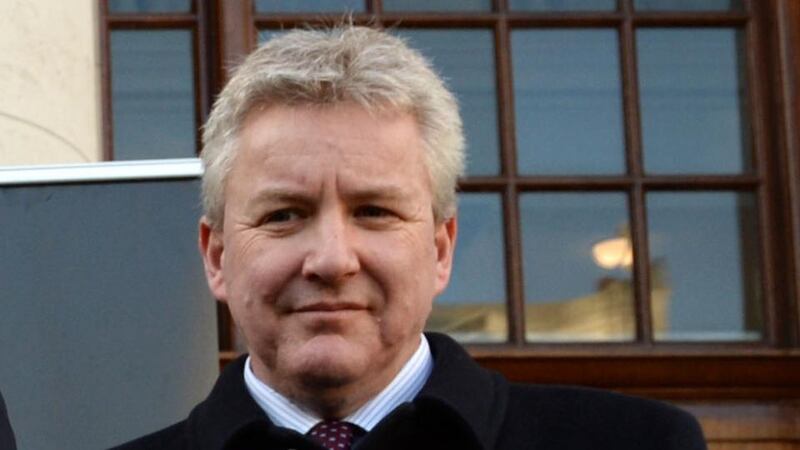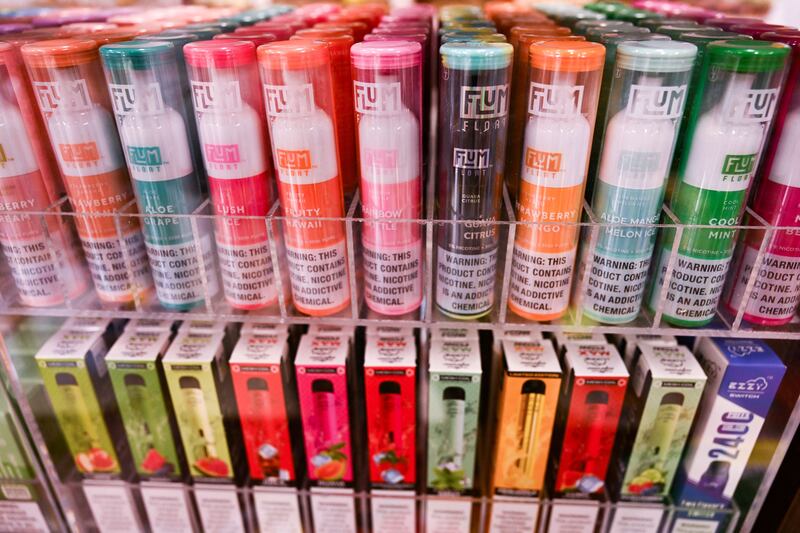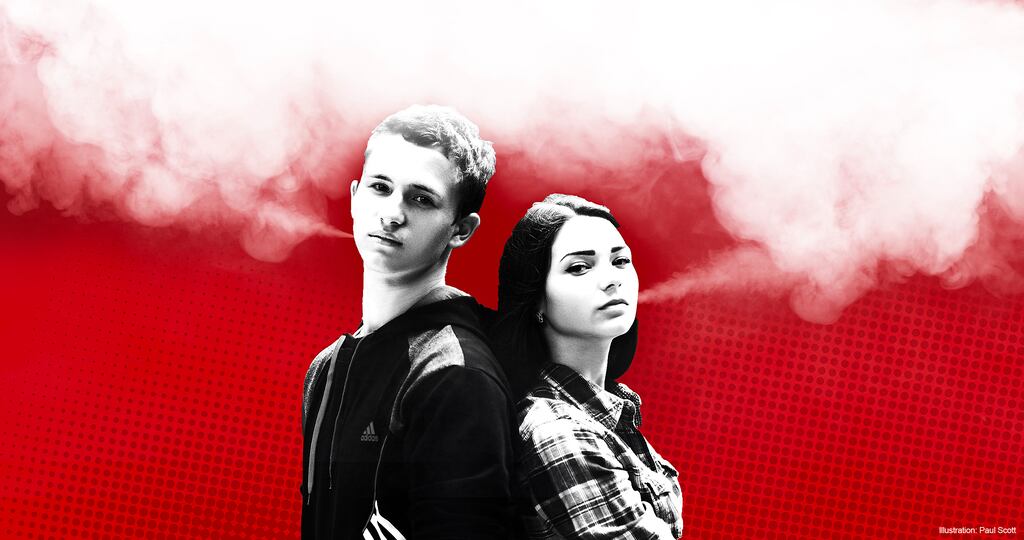Christina* had her first experience of vaping when she was in fifth year, in an empty classroom adjacent to her engineering class on a Friday morning. “I coughed my lungs up. I was so scared I’d get caught.”
By time she was in sixth year, brightly coloured disposable e-cigarettes arrived on to the market. “And that’s when the trend exploded”, sweeping through her Donegal school with the same fever as the loom bands phase 10 years earlier.
After a night out, ‘the feeling in your chest is horrific — it’s like somebody sprayed strawberry air freshener in your mouth’
The most popular brand of disposable vapes among her friendship group currently sell for around €7 each, with one offering 500-600 puffs. They come in flavours such as watermelon ice and raspberry orange blossom. “They’re like the Jolly Ranchers of vapes,” Christina says, referencing a popular sweet — except that most contain 20mg or 2 per cent nicotine. This is equivalent to the amount of nicotine a smoker would get from 20 cigarettes/, though of course traditional smokers are exposed to additional harmful chemicals. Christina’s friends were often getting through one a day. After a night out, “the feeling in your chest is horrific — it’s like somebody sprayed strawberry air freshener in your mouth”

Almost overnight, or so it seemed, vaping was everywhere. TikTok influencers were doing it. And in school, “everybody was using them. People were vaping left right and centre, they were leaving classes to vape, they were vaping in the toilets at break time.”
‘It’s not soccer money’ - Jamie Heaslip reflects on entering the business world after rugby
‘My son was killed in front of my eyes. Three bullets in his chest’: Patrick Freyne in Chad’s desert camps
Wealth gap tensions: ‘My friends don’t have to budget like me. A round of cocktails scares the s**t out of me’
Now 19, she prefers cigarettes on a night out and a vape could last her two weeks. But in the chip shop where she works, “every 10 or 15 minutes, someone is asking can I go out for a vape. Everybody is doing it because everybody else is doing it.”
I hate that I have to question and time a student when they use the toilet
Christina’s observations are echoed by those of Alison*, a teacher at a south Dublin school. Her school has taken to monitoring toilet breaks in an effort to clamp down on vaping. Students write into their homework diary the time they leave and when they get back. “I hate that I have to question and time a student when they use the toilet. I know it’s awful. But it’s for their health and safety. No parent will be impressed if they find out their child was regularly vaping during class time.”
A teacher for nearly 25 years, she seems mystified to find herself back monitoring nicotine use by young people. “There was actually a long time when smoking just wasn’t an issue at all. Kids just didn’t seem to smoke.”
Uptick in smoking
“Smoking among children has been decreasing for 20 years. From 1995 until 2015, every time we measured it, it went down,” says Prof Luke Clancy, founder of Tobacco Free Research Institute Ireland and one of the authors of the European Schools Project on Alcohol and Other Drugs (ESPAD). And then, apparently out of nowhere, “it went up in 2019”.

The survey detected an uptick in the numbers of those aged 15 to 17 who were smoking cigarettes — from 13 per cent in 2015 to 14.4 per cent in 2019. At the same time, rates of vaping among young people are also rising. The ESPAD survey found that e-cigarette use among Irish 15- to 17-year-olds increased from 10 per cent to 18 per cent between 2015 and 2019. The State of Tobacco Control report published earlier this year reported that, among those aged 15 to 24, vaping increased from 1 per cent to 4 per cent between 2015 and 2021.
“I think it’s reasonable for us to expect that that trend has continued upward,” says Dr Paul Kavanagh, public health medical adviser to the HSE’s Tobacco Free Ireland Programme.
Chris Macey, director of advocacy at the Irish Heart Foundation, puts it even more bluntly. He believes the arrival on to the market of attractively packaged disposable vapes has led to “an explosion” in their use.

“They’re cheaper, easier in that they don’t need a charger. According to the World Health Organisation, there’s 16,000 different flavours. There’s bubblegum, chocolate cookies, gummy bears. How would you need gummy bear flavour to make you quit?” He is concerned about the stealth marketing of vaping through social media, using hashtags linked by outside parties to GAA events and concerts, or by influencer promotion.
We’re seeing an increase in both teenage tobacco smoking and vaping. The question that hasn’t yet been satisfactorily answered is which came first. An evidence review by the Health Research Board, commissioned by the Department of Health in 2020, found that “compared with children who never vaped, children who were using e-cigarettes were three to five times more likely to go on and start smoking. I don’t think we need to wait to a point where we get to beyond reasonable doubt that there’s a relationship between vaping and smoking to intervene,” says Dr Kavanagh.
‘Nicotine is one of the most highly addictive substances known to mankind. So you only have a certain amount of time with this before the horse has bolted’
Macey believes we should be “absolutely petrified that all of those hard-won gains of the last generation of tobacco control are going to be lost now, and they’re going to be lost to complacency. Nicotine is one of the most highly addictive substances known to mankind. So you only have a certain amount of time with this before the horse has bolted.”
‘Unsmoking’
Non-combustible tobacco devices were not supposed to act as a gateway to smoking, if that is indeed what they turn out to be. The first products were patented in the US in the 1960s as an alternative to cigarettes, but never commercialised. In 2003, the idea was revived by a Chinese pharmacist, Hon Lik, after his father died of lung cancer.
Big Tobacco regarded e-cigarettes as a passing fad at first, but from 2012 onwards began muscling in, buying up smaller e-cigarette companies and introducing a sophisticated marketing and lobbying playbook to the burgeoning industry. All the big four — Philip Morris, British American Tobacco, Imperial Brands and Altria — subsequently branched out into vaping with their own brands. Altria famously bought a 35 per cent stake in Juul for $12.8 billion in 2018. They use language such as “unsmoking”, “next generation products” and “a non-combustible future”.

One of the strategies of some pro-vaping groups is to create confusion about what e-cigarettes are actually for, by marketing them simultaneously as a smoking cessation device and a cool new consumer product. Part of the aim of this confusion, says Tobacco Tactics at the University of Bath, is to delay regulation. And it seems to be working.
In the UK, Public Health England takes a much more liberal attitude to e-cigarettes than the majority of EU countries, New Zealand and the United States. Ireland doesn’t seem entirely sure which approach to follow.
The reality is, today in a kid can walk into a vape shop in Bray, Mullingar or west Cork and be sold a product
The Joint Committee on Health, Tobacco and Nicotine Inhaling Products report was published last July, making 10 recommendations, including a ban on the sale of e-cigarettes to under 18s. Several experts argued for it to go further, adding a flavour ban and restrictions on packaging. Since then, the Public Health (Tobacco and Nicotine Inhaling Products) Bill 2019, which would implement that ban on sales to under-18s, has not yet been enacted. This means that 10 years after the idea of legislation was first mooted, Ireland remains one of the only countries in the EU where a child can legally purchase vaping equipment.
“The reality is, today in a kid can walk into a vape shop in Bray, Mullingar or west Cork and be sold a product. There’s no legal prohibition in terms of that,” says Dr Kavanagh.
“That is a huge gap that we need to close off. We have good reason to be concerned that vaping may lead children to go on and smoke. And we need to recognise that for our children and young people, vaping is [itself] associated with risk. Vaping administers nicotine, a highly addictive substance. There is a volume of evidence showing the effect that nicotine has on the developing brain. Then there are questions in terms of what the long-term health impacts may be. So absolutely, we need to take action in terms of the current Tobacco and Nicotine Inhaling Products Bill that is with Government.”
Difficult to prove
When you speak to those who support a liberal approach to vaping, the same arguments tend to crop up again and again. While researching this article, I was contacted by Joe Dunne who described himself as founder of Respect Vapers, “which represents up to 200,000 people who vape to quit smoking”.
Dunne made several of the same arguments that can be found on the online FAQ sections of vaping businesses, including that the vast majority of vapers are smokers are ex-smokers. Like others who support the vaping industry, he is in favour of a ban on under-18s buying e-cigarettes but against a ban on flavours, which he says are used by 70 per cent of former smokers.
He suggests that if vapes did not exist, teenage vapers would be smoking cigarettes instead, a claim which seems equally difficult to prove or disprove. “Doctors will tell you that those young people would have had a propensity to smoke or vape. If vaping wasn’t there, they would have smoked.”

He is not a smoker-turned-vaper himself, it turns out. He got involved because he was doing some work with the Irish Vape Vendors Association (IVVA). Respect Vapers, he explains, gets no funding “from the vaping industry, not from tobacco, not from anybody in the industry at all.” It is funded by the Edmund Burke Institute, which describes itself as “Independent, non-partisan and funded entirely through private donations of individuals and organisations”.
However, this newspaper previously reported that the Edmund Burke Institute has received funding from the Atlas Network, a US-based organisation which is cultivating a global network of right-wing think tanks. Atlas Network itself was the recipient of donations from the tobacco industry. A 2017 peer-reviewed study by researchers of Simon Fraser University in Canada described it as a long-standing “strategic ally” of Big Tobacco.
Asked about this, Dunne said: “I know nothing about any US-based groups.”
Flavour ban
Often, the only sign a teenager has been vaping at school is the faint, sickly sweet smell in the toilets or changing rooms, says David*, a school principal in the south of the country. He cannot remember the last time he smelled cigarette smoke, but finding evidence of vaping is a daily occurrence. He rattles a huge bag of vapes he confiscated over the last year. “You walk in and the place is stinking of some sweet smell, but often you’ve no way of knowing who has been vaping. These kids have never smoked, but they’re all vaping, because it’s something to do, it’s a hint of rebellion, it’s to be in with the cool gang.”
Among teenagers generally, vaping has reached “epidemic proportions”.
Our main and our only goal is to help smokers give up cigarettes and use something that is a healthier alternative
If vaping is meant for adults who want to get off cigarettes, he asks, “why is it being sold in these childish fruity flavours? It’s the same thing as the drinks industry did with alcopops.”
Joanne O’Connell, a retailer and member of IVVA, says the industry has been “pushing and pushing” for the ban on sales to under 18s. “For the industry at large, having teenagers vaping is not good. Ninety per cent of the industry just wants to help people give up smoking.”
[ Is it time to quit vaping? What the science saysOpens in new window ]
In her own store, she refuses to sell to under-18s and is not opposed to a ban on under-21s buying e-cigarettes. “Our main and our only goal is to help smokers give up cigarettes and use something that is a healthier alternative.”
However, she draws the line at the flavour ban. “We’ve never sold to under-18s, and flavours are still hugely popular. People will start off with a tobacco flavour, but once you’ve been off tobacco for a while, your taste buds come back and you want to get away from smoking completely.” Maybe, she suggests, “there is a balance to be had. You can have flavours without them being attractive to kids.”
‘As somebody who works in tobacco control, there is a sinister familiarity to the playbook here. It’s about recruiting and retaining new users of the product’
“Let’s just do a reasonability test here,” says Dr Kavanagh. “If you look at somebody who is in their early 60s who has been smoking maybe for 40 or 50 years, who has now got lung disease and heart disease caused by their smoking, do we really think that bubblegum flavoured, popcorn flavoured or watermelon flavoured e-cigarette products are what they’re looking for?
“As somebody who works in tobacco control, there is a sinister familiarity to the playbook here. It’s about recruiting and retaining new users of the product. The evidence is, at best, not very compelling that these flavours are associated with current smokers switching over to e-cigarettes.”
Health effects
Researchers are concerned about vaping acting as a gateway to smoking, but they are also worried about the as-yet-unknown long-term health risks to young people.
“As a respiratory physician, I’m worried [about people] inhaling flavours into their lungs. If you ingest or eat a melon, that’s fine. But if you inhale it into your lungs, we do not have any idea what it will do,” says Prof Clancy.
If people who are developing e-cigarettes are genuinely interested in public health, there is a path open to them to put these products before the Health Products Regulatory Authority and have them examined
Not enough is yet known about the long-term impacts of e-cigarettes. Initial studies suggest that vaping “causes a little bit of airways obstruction in your lungs. It irritates some people. But it takes years” for the impact of inhaled chemicals to fully show up. However, what we already know should be enough to cause alarm.
“Quite apart from the physical effects, they are addictive. Nearly half of the children in this country have tried them. Eighteen per cent of 16-year-olds are regularly using e-cigarettes. When you become addicted to nicotine as a child, it influences your brain development. Nobody seems to care that we’re selling things that deliberately addict our children. If they’re good for smoking cessation, which they are some good, why don’t we treat them like other smoking cessation products and license them?”

If such high numbers of teenagers are vaping, are their parents aware? Prof Clancy points to a perhaps unexpected finding in the research: the children of parents with third-level education are more likely to vape. “There needs to be targeting of parents as well, because they have obviously taken on board that they’re harmless, or they’re good.”
Parents are concerned, says David, the school principal, but they’re confused by the mixed messaging. “They don’t know what the long-term effects are.”
He believes most have no idea how widespread it is and are invariably surprised to discover their child has been vaping. “I think most teenagers have tried it. Nearly all will have been offered it from 12 years of age.”
Big Tobacco playbook
There may be a role for e-cigarettes to help some smokers who want to quit, says Dr Kavanagh. “It’s not a simple binary. It’s not black or white. Everything has to be broken down for different parts of the population. If people who are developing e-cigarettes are genuinely interested in public health, there is a path open to them to put these products before the Health Products Regulatory Authority and have them examined,” he says.
“But we have to look at the reality here. Everything we’re talking about between flavours, sponsorship, product placement, marketing on social media — there are libraries full of studies showing how this was perfected by the tobacco industry. And here we are seeing the same playbook playing out in relation to e-cigarettes.”
The Department of Health said the Public Health (Tobacco Products and Nicotine Inhaling Products) Bill is currently being drafted by the Office of the Attorney General. The Bill is a priority for drafting and publication in the autumn legislative programme approved by Cabinet in September. The draft Bill is expected to be completed and published by year end and to be brought into the Houses of the Oireachtas for enactment in 2023.
The Department said that by prohibiting the sale of electronic cigarettes to under 18s and introducing a licensing system for the retail sale of electronic cigarettes the Bill aims to reduce the availability of electronic cigarettes to young people and ensure greater regulation of the retail environment.
The National Stop Smoking Clinical Guideline was published in January 2022 and offers advice to healthcare professionals on how to support people to stop smoking. The Department said the Guideline recognises that some people may choose to use electronic cigarettes in their attempt to quit smoking, a fact borne out by the Healthy Ireland Survey 2021 which found that 18 per cent of those who tried to quit smoking used electronic cigarettes - 38 per cent of smokers reported using electronic cigarettes in their attempt to quit in the 2019 Healthy Ireland Survey.
The HSE Quit service does not recommend using electronic cigarettes to help to give up smoking but it does offer support to those already using electronic cigarettes in their attempts to stop, the Department added.
* Some names were changed to protect the identities of the schools.


















